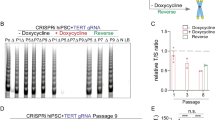Previous studies showed that Cd++ inhibits EGF-induced DNA synthesis that not EGF-induced myc mRNA accumulation or amino acid incorporation into protein in serum-starved NRK-49F cells. In this study, flow cytometry was used to analyze the DNA and protein content of individual cells stimulated with Cd++ and/or epidermal growth factor (EGF). myc oncogene expression in these cells was also measured. It was found that, in both parental NRK-49F cells and in a clonal subpopulation, N1, Cd++ induces an hypertrophic response. In parental NRK-49F cells, however, lower doses of Cd++ (0.5 μM) induced more pronounced hypertrophic responses than did higher doses (4 μM); whereas in N1 cells, the Cd++-induced hypertrophic response shows a pattern of increasing response with doses of Cd++ from 0.5 to 4 μM. myc mRNA accumulation measured 2 hours after stimulation correlated with the hypertrophic responses in both NRK-49F cells and in N1 cells. The results show that Cd++-induced hypertrophy in NRK-49F cells is associated with increased myc oncogene mRNA accumulation, indicating that cell proliferation and cell hypertrophy may in part share common activation pathways.
Similar content being viewed by others
Abbreviations
- EGF:
-
Epidermal growth factor
- FCM:
-
Flow cytometric analysis
- FITC:
-
fluorescein isothiocyanate
- PI:
-
propidium iodide
References
ARMSTRONG, B.G. and KAZANTZIS, G. (1985). “Prostatic cancer and chronic respiratory and renal disease in British cadmium workers: a case control study.” Br. J. Ind. Med. 42: 540–545.
ATTERWILL, C.K. and KIMBER, I. (1990). “Meeting Report: Hyperplastic and hypertrophic responses in toxicity and carcinogenesis.” Toxic. in Vitro. 4: 795–797.
CRISSMAN, H.A. (1985). “Correlated measurement of DNA, RNA, and protein in individual cells by flow cytometry.” Science 228: 1321–1324.
CRISSMAN, H.A. and STEINKAMP, J.A. (1982). “Rapid one step staining procedures for analysis of cellular DNA and protein by single and dual laser flow cytometry.” Cytometry 3: 84–90.
ENGER, M.D., FLOMERFELT, F.A., WALL, P.L., and JENKINS, P.S. (1987). “Cadmium produces a delayed mitogenic response and modulates the EGF response in quiescent NRK cells.” Cell Biol. and Toxicol. 3: 407–416.
FUKE, M., DENNIS, K.J., and BUSCH, H. (1981). “Characterization of clonal rat ribosomal DNA fragments.” Mol. Gen. Genet. 182: 25–30.
GALANTI, N., JONAK, G.J., SOPRANO, K.J., FLOROS, J., KACZMAREK, L., WEISSMAN, S., REDDY, V.B., TILGHMAN, S.M., and BASERGA, R. (1981). “Characterization and biological activity of cloned simian virus 40 DNA fragments.” J. Biol. Chem. 256: 6469–6474.
GUNN, S.A., GOULD, T.C., and ANDERSON, W. (1967). “Specific response of mesenchymal tissue to cancerogenesis by cadmium.” Arch. Pathol. 83: 493–499.
HADDOW, A., ROE, F.J.C., DUKES, C.E., and MITCHLEY, B.C.V. (1964). “Cadmium neoplasia: Sarcomata at the site of injection of cadmium sulphate in rats and mice.” Br. J. Cancer 18: 667–673.
JIN, P. and RINGERTZ, N.R. (1990). “Cadmium induces transcription of proto-oncogenes c-jun and c-myc in rat L6 myoblasts.” J. Biol, Chem. 265: 14061–14064.
KJELLSTROM, T., FRIBERG, L., and RAHNSTER, B. (1979). “Mortality and cancer morbidity among cadmium-exposed workers.” Environ. Health Perspect. 28: 199–204.
LAUWERYS, R. (1979). “Cadmium in man.” In: The chemistry, biochemistry and biology of cadmium (M. Webb, ed.). Elsevier/North-Holland Biomedical Press, Amsterdam. pp. 433–455.
LEMEN, R.A., LEE, J.S., WAGENER,J.K., and BLEJER, J.P. (1976). “Cancer mortality among cadmium production workers.” Ann. NY Acad. Sci. 271: 273–279.
MULLER, R., BRAVO, R., and BURCKHARDT, J. (1984). “Induction of c-fos gene and protein by growth factors precedes activation of c-myc.” Nature 312: 716–720.
MACMASTER, G.K. and CARMICHAEL, G.G. (1977). “Analysis of single and double stranded nucleic acids on polyacrylamide and agarose gel by using glyoxal and acridine orange.” P.N.A.S. 74: 4035–4038.
MITCHISON, J.M. (1971). The Biology of the Cell Cycle. Cambridge University Press, UK.
SHAPIRO, H.M. (1988). “Light scattering and cell size.” In: Practical flow cytometry (second ed.). Alan R. Liss Inc., NY. pp. 116–177.
SMITH, J.B., DWYER, S.D., and SMITH, L. (1989). “Cadmium evokes inositol polyphosphate formation and calcium mobilization.” J. Biol. Chem. 264: 7115–7118.
SOPRANO, K.J., GALANTI, N., JONAK, G.J., MCKERCHER, S., PIPAS, J.M., PEDEN, K.W.C., aand BASERGA, R. (1983). “Mutational analysis of SV40 T antigen: Stimulation of cellular DNA synthesis and activation of ribosomal RNA genes by mutants with deletions in the T antigen gene.” Mol. Cell. Biol. 3: 214–219.
STARKSEN, N.F., SIMPSON, P.C., BISHOPRIC, N., COUGHLIN, S.R., LEE, W.M.F., ESCOBEDO, J.A., and WILLIAMS, L.T. (1986). “Cardiac myocyte hypertrophy is associated with c-myc ptotooncogene expression.” P.N.A.S. 83: 8348–8350.
STUDZINSKI, G.P., BRELVI, Z.S., FELDMAN, S.C., and WATT, R.A. (1986). “Participation of c-myc protein in DNA synthesis of human cells.” Science 234: 467–470.
TANG, N., CLAPPER, J.A., and ENGER, M.D. (1991).“Cadmium inhibits EGF-induced DNA synthesis but not EGF-induced myc mRNA accumulation.” Cell Biol. and Toxicol. 7: 35–47.
TANG, N., CUNNINGHAM, K., and ENGER, M.D. (1991). “TGFβ Elicits Opposite Responses in Clonal Subpopulations of NRK-49F cells.” Exp. Cell. Research 196: 13–19.
TERRACIO, L. and NACHTIGAL, M. (1988). “Oncogenicity of rat prostate cells transformed in vitro with cadmium chloride.” Arch. Toxicol. 61: 450–456.
WEBB, M., HOLT, D., BROWN, N., and HARD, G.C. (1988). “The teratogenicity of cadmium-metallothionein in the rat.” Arch. Toxicol. 61: 457–467.
WEBB, M. (1979). “Interactions of cadmium.” (M. Webb, ed.). Elsivier/North-Holland Biomedical Press, Amsterdam, pp. 285–340.
ZETTERBERG, A., ENGSTROM, W., and LARSSON, D. (1982). “Growth activation of resting cells: induction of balanced and imbalanced growth.” Ann NY Acad. Sci. 397: 130–147.
Author information
Authors and Affiliations
Rights and permissions
About this article
Cite this article
Tang, N., Enger, M.D. Cadmium induces hypertrophy accompanied by increased myc mRNA accumulation in NRK-49F cells. Cell Biol Toxicol 7, 401–411 (1991). https://doi.org/10.1007/BF00124074
Issue Date:
DOI: https://doi.org/10.1007/BF00124074




